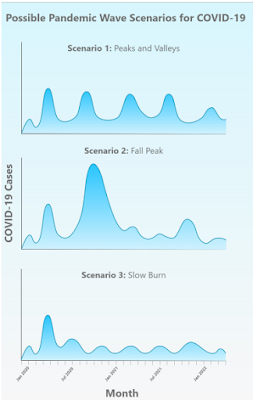#15,228
If you wanted to put together a `dream team' of independent experts to analyse the current status of the COVID-19 pandemic - and its likely future course - you'd be hard pressed to do better than having 3 world class epidemiologists and the man who literally wrote the book on the 1918 Spanish Influenza.
That's exactly the pedigree of a new, and ongoing series of reports called COVID-19: The CIDRAP Viewpoint - authored by Kristine Moore, MD, MPH, Marc Lipsitch, DPhil, John Barry, MA, and Michael Osterholm, PhD, MPH - all of whom are well known to readers of this blog.The first installment, released yesterday (Part 1: "The future of the COVID-19 pandemic: lessons learned from pandemic influenza" (Apr 30, 2020)) on the CIDRAP website, paints a sobering picture of what is likely to transpire with the pandemic over the next 18-24 months.
The report presents three different scenarios (see graphic below), all with one common theme; COVID-19 is going to be with us until sufficient herd immunity (roughly 60%-70%) is reached to dampen transmission.
The second, and most concerning scenario, envisions a second, much larger pandemic wave next fall or winter, followed by a series of smaller waves into 2021-2022. This is very much like the pattern seen in the 1918-1919 pandemic.
While it is not the only possibility - it is the `worst case' of the three - and the one we must be prepared for.Excerpts from the Welcome Message, and a link to the full 9-page Report below. You'll want to read the full report in its entirety, along with any future installments. I'll have a brief postscript when you return.
COVID-19: The CIDRAP Viewpoint
Part 1: "The future of the COVID-19 pandemic: lessons learned from pandemic influenza" (Apr 30, 2020)
Welcome to "COVID-19: The CIDRAP Viewpoint." We appreciate that other expert groups have produced detailed plans for mitigating SARS-CoV-2 transmission and for reopening the country after stay-at-home orders and other important mitigation steps are eased. Our intent with the Viewpoint is to add key information and address issues that haven't garnered the attention they deserve and reflect the unique experience and expertise among the CIDRAP team and our expert consultants.
We will address timely issues with straight talk and clarity. And the steps we will recommend will be based on our current reality and the best available data. Our goal is to help planners envision some of the situations that might present themselves later this year or next year so that they can take key steps now, while there’s still time.
"COVID-19: The CIDRAP Viewpoint" will address such topics as pandemic scenarios going forward, crisis communication, testing, contact tracing, surveillance, supply chains, and epidemiology issues and key areas for research. We will release approximately one to two reports per week.
Our hope is that our effort can help you plan more effectively and understand the many aspects of this pandemic more clearly—and for you and your family, friends, and colleagues to be safer.
In the first report, published Apr 30, 2020, "The future of the COVID-19 pandemic: lessons learned from pandemic influenza," Kristine Moore, MD, MPH, Marc Lipsitch, DPhil, John Barry, MA, and Michael Osterholm, PhD, MPH, paint a picture of the pandemic and detail how it's behaving more like past influenza pandemics than like any coronavirus has to date. And, because of that, certain inferences can be drawn — such as the fact that it may well last 18 to 24 months, especially given that only 5% to 15% of the U.S. population is likely infected at this point.
Key recommendations from the report:
(Continue . . . )The first CIDRAP Viewpoint report lays out three scenarios for how cases might ebb and flow in the coming months. No one knows exactly how this virus will behave. But, based on what scientists have recorded so far and on previous influenza pandemics, the report illustrates some of the possibilities.
- States, territories, and tribal health authorities should plan for the worst-case scenario (which involves a large second peak of cases in the fall of 2020), including no vaccine availability or herd immunity.
- Government agencies and healthcare delivery organizations should develop strategies to ensure adequate protection for healthcare workers when disease incidence surges.
- Government officials should develop concrete plans, including triggers for reinstituting mitigation measures, for dealing with disease peaks when they occur.
- Risk communication messaging from government officials should incorporate the concept that this pandemic will not be over soon and that people need to be prepared for possible periodic resurgences of disease over the next 2 years.
For decades world leaders have largely ignored pandemic preparedness, believing that the myriad warnings of another severe pandemic were `overblown' (see The Most Predicted Global Crisis of the 21st Century) or that modern medicine could somehow `handle' it if one ever came
And so we found ourselves woefully unprepared for the arrival of COVID-19.While no one has a crystal ball and can predict exactly how this novel coronavirus pandemic will behave in the months ahead, the three scenarios presented in this CIDRAP report are far more likely - at least based on what we know today - than the virus being miraculously eradicated or greatly subdued in the months ahead.
While it won't be easy, through the great social and economic sacrifices of billions of people over the past few months, we've bought ourselves a rare second chance to prepare for the next phases of this pandemic.We just need to be smart enough this time, to actually take it.

